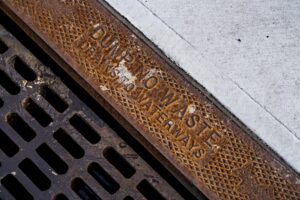What is Stormwater & Why Does the Government Care about It?
Stormwater drainage is a massive topic in 2022. As more severe weather patterns emerge, governments are focusing on declining infrastructure. We often don’t think about it, but the United States is a young nation compared to other countries. Yet, our gray infrastructure is starting to encounter growing pains with stormwater with aging cities. The definition of stormwater, of course, is water from rain events and snowmelt that runoffs off the land. This article will break down how our local governments plan to empower communities to help assist in stormwater drainage issues.
Where does Stormwater Go?
Stormwater management starts with gray infrastructure, the systems engineered on public property. Gray infrastructure gets a lot of attention because of the grave importance of its utility. Massive public storm drains move water away from properties to prevent damage. Our taxes help pay for these systems to keep us environmentally and economically healthy.
Over time, as cities continue to grow to fit the needs of more and more residents, more hardscapes have popped up. We need more surface space for buildings, roads, and sidewalks. This concrete makes water runoff flow faster, and at higher velocity into stormwater drains. With more water entering drainage systems, there is pressure on plans to keep up with water flow. In systems with high overflow, contaminated water can move out into streets and local waterways. This can make people sick from viral and bacterial infections. The concern for public health, environment and economic growth has led local cities to seek ways to offset water runoff.
What is Stormwater Management?
In the 70s, it became clear that pollution was a growing problem. (Air pollution was 5x worse in the 1970s than today.) A growing public concern led President Nixon to declare his intent to work on pollution control during his term. This was also during the time of the “flower child.” Progressive environmental thought on college campuses was influencing government agendas.
When faced with growing environmental problems, stormwater management was one area that became a necessity for engineering and regulation. Municipal programs were to receive more financing, and with money came code to make sure funds were appropriately used. For stormwater, this all started in 1973 with the Clean Water Act.
The Clean Water Act and NPDES
The Clean Water Act was passed during the LBJ presidency. This legislation penalized water point sources that were polluting waterways. Unless the point source had a permit from the National Pollution Discharge Elimination System (NPDES), in that case, the polluter wouldn’t be penalized. So, for example, a shopping mall could file for a permit from the NPDES if they know that their property has a lot of water runoff each year. In 1973, the U.S. EPA (Environmental Protection Agency) started to exempt some stormwater dischargers from permitting requirements. Except in cases where significant pollution was happening.
With the start of stormwater management in the 70s, states took on managing and enforcing the rules of NPDES. Most states place fees and taxes on large polluters through the State Water Board. While oversight and regulation of significant stormwater runoff drainage help keep ecosystems steady, growing demands were outpacing law and infrastructure. So the government had to start getting creative.
Stormwater Retention and Green Infrastructure
Federal and state agencies decided to approach stormwater drainage by adding two methods. The first is stormwater utility fees, using taxes from these fees to help pay for infrastructure upgrades. The other is stormwater retention methods. Instead of gray infrastructure, the government looked towards “green infrastructure,” which focuses on recreating natural solutions-nature-based solutions- to help filter out pollutants. Green infrastructure regarding stormwater meant building technologies that would redirect water traffic. For example, instead of using traditional asphalt, using concrete was porous and would let more water seep into the ground. Or using specific downspouts on homes that would move water into certain areas. If retention on a property wasn’t possible, stormwater technologies like bioswales help water flow off-site. Municipalities receiving funds made sure to set aside a budget to help property owners use stormwater infrastructure technologies.
Your City Wants You to Use Stormwater Incentives
The most reliable way to get people motivated is to incentivize them with economic rewards—especially property owners who know and need a break in costs on property repairs or upgrades. Stormwater incentive programs fluctuate each year and are usually carried out by city programs and nonprofits. These incentive programs reward property owners who upgrade to green infrastructure by giving them a rebate to pay for some building costs, lowering stormwater utility fees, and other methods.
Our federal, state, and local governments emphasize stormwater runoff because they know the impact of water runoff on the economy (property damage claims, loss of food from contamination), the environment, and public health. We all live in an ecosystem that is dependent on many factors, and water is an intricate part of the system.
Where You Can Find Incentives
The trick to stormwater incentives is knowing where to apply for them and what you will need in place to get approved. Rainplan was created in 2019 for this very purpose. Our goal is to provide you with a free service that connects you with local incentive programs. These programs are specific to your property, and we also set up a dashboard for you to learn more and get notified of when these programs open up for applications.
To apply for a stormwater incentive, you’ll need specific project paperwork, and you’ll need to be on their waiting list of participants. Rainplan makes the stress of bureaucracy easier by filing and handling large stormwater incentive applications for you. We give you a Rainplan checklist, help you find a contractor, and lead you on the path towards receiving your incentive.
Get started by searching for an incentive program here!



